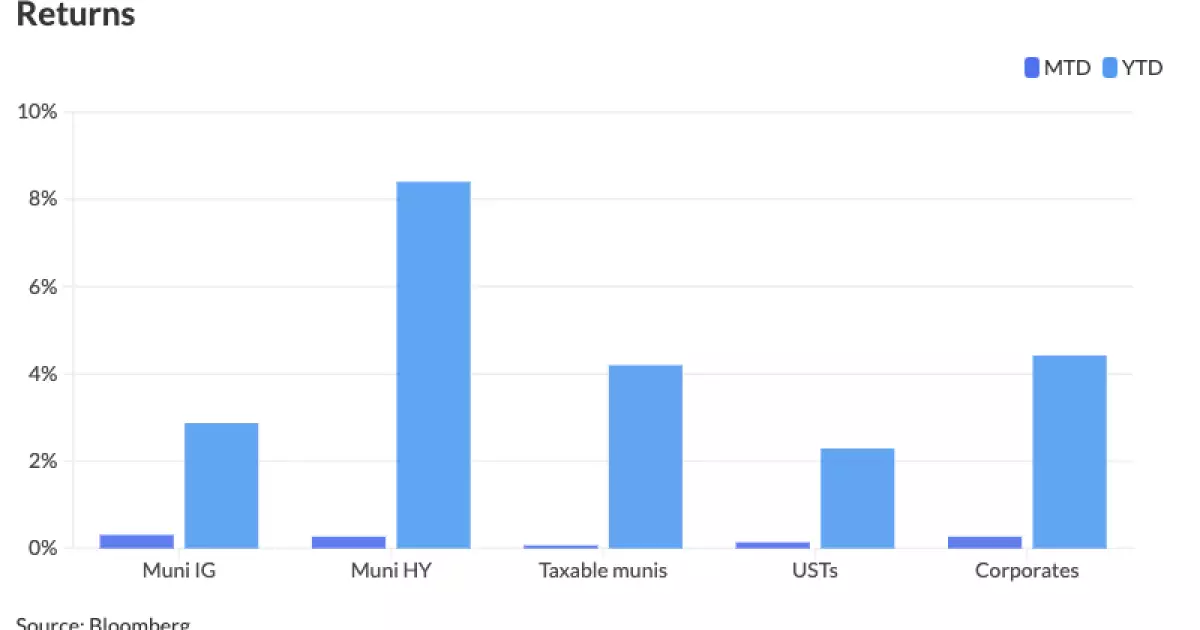The municipal bond market operates like a living organism, constantly adapting and responding to external influences, such as economic news, interest rate changes, and supply-demand dynamics. The recent trends observed indicate a nuanced interplay between municipal bonds and U.S. Treasury securities, suggesting that current fluctuations in municipal yields amid changing market conditions warrant a closer examination.
On a recent trading day, municipal bonds portrayed signs of slight weakness as investors absorbed a wave of new offerings while simultaneous shifts occurred in the Treasury market. Investors witnessed municipal yields edging up by as much as two basis points. In contrast, U.S. Treasury yields experienced a modest increase, ranging from one to two basis points. Such movements underscore the interconnected nature of financial markets, where changes in one sector invariably impact another. The current ratios between municipal and Treasury yields signal heightened investor caution, emphasizing the need for strategic allocation of assets amid evolving market landscapes.
For example, as per the latest data, the two-year municipal to UST ratio was reported at 61%, with parallel shifts observed across various timeframes. Comparisons like these provide ample insight into changing investor sentiment and risk appetite. The latter is further evidenced by the upward movement of Treasury yields, suggesting that the broader economic outlook may be prompting investors to recalibrate their risk thresholds.
Despite these fluctuations, municipal bonds have demonstrated commendable resilience, exhibiting an impressive year-to-date growth of 2.87%. Industry experts, such as Anders S. Persson and Daniel J. Close, assert that this positive performance continues to build momentum, suggesting an optimistic outlook for both the remainder of this year and the upcoming months. They attribute this strength partly to robust reinvestment activities expected around January 1, a crucial date that often brings in substantial cash flow into the market.
Furthermore, the stark backdrop of nearly $500 billion in new issues this year highlights a strong demand despite oversupply concerns. According to Daryl Clements from AllianceBernstein, the net supply picture is expected to offer a significant tailwind, thus enhancing overall returns for investors holding municipal bonds. The market’s resilience, illustrated by a rise of 1.73% in November, reveals a recovery from previous losses in October, confirming that savvy investors can weather economic headwinds with the right approach.
Investor appetite for municipal securities also appears robust, with mutual funds and exchange-traded funds noting a remarkable influx of $42 billion year-to-date. Particularly noteworthy is the involvement of high-yield funds, which accounted for a substantial 38% of total flows, indicating an emerging “risk-on” mentality among bond investors. The ability of high-yield municipal bonds to yield an impressive year-to-date increase of 8.4% underscores this trend, suggesting a willingness among investors to venture into riskier territory given attractive returns.
Looking ahead, signs point towards a potentially favorable technical backdrop as the Federal Reserve is primed to cut rates by 25 basis points in an upcoming meeting. This anticipation of lower rates aligns with the demand environment as well as historical performance metrics, all contributing to a favorable position for municipal bonds.
The primary market remains active, showcasing a series of new issues designed to meet investor demand. Recent syndicated deals include substantial financings by major entities, including the Dormitory Authority of the State of New York, the Chicago Transit Authority, and various other regional authorities. These issues, characterized by varying structures and credit ratings, provide multiple avenues for investing, underscoring the dynamic nature of the municipal market.
With the impending issuance of more municipal certificates and bonds in the coming weeks, indications suggest that investors will have ample opportunity to engage with high-quality offerings. As the market gears up for future transactions, firms like Jefferies LLC and BofA Securities are playing pivotal roles in facilitating these opportunities.
In summation, the municipal bond market appears well-positioned for robust performance moving forward into 2024. The underlying fundamentals, coupled with strong technical momentum and a cautious investment climate, create a compelling narrative for both new and seasoned investors. While inherent risks remain, particularly regarding external economic shocks, the overarching sentiment points toward a promising horizon for municipal bonds. Investors would do well to maintain a close watch on developments, strategic allocations, and evolving demand dynamics in this ever-changing financial landscape.

